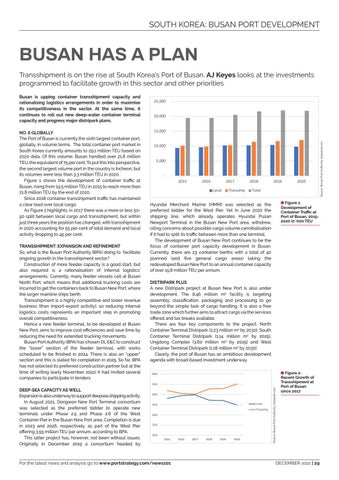SOUTH KOREA: BUSAN PORT DEVELOPMENT
BUSAN HAS A PLAN Transshipment is on the rise at South Korea’s Port of Busan. AJ Keyes looks at the investments programmed to facilitate growth in this sector and other priorities
NO. 6 GLOBALLY The Port of Busan is currently the sixth largest container port, globally, in volume terms. The total container port market in South Korea currently amounts to 29.1 million TEU based on 2020 data. Of this volume, Busan handled over 21.8 million TEU, the equivalent of 75 per cent. To put this into perspective, the second largest volume port in the country is Incheon, but its volumes were less than 3.3 million TEU in 2020. Figure 1 shows the development of container traffic at Busan, rising from 19.5 million TEU in 2015 to reach more than 21.8 million TEU by the end of 2020. Since 2018 container transshipment traffic has maintained a clear lead over local cargo. As Figure 2 highlights, in 2017 there was a more or less 5050 split between local cargo and transshipment, but within just three years the position has changed, with transshipment in 2020 accounting for 55 per cent of total demand and local activity dropping to 45 per cent. TRANSSHIPMENT: EXPANSION AND REFINEMENT So, what is the Busan Port Authority (BPA) doing to facilitate ongoing growth in the transshipment sector? Construction of more feeder capacity is a good start, but also required is a rationalisation of internal logistics’ arrangements. Currently, many feeder vessels call at Busan North Port, which means that additional trucking costs are incurred to get the containers back to Busan New Port, where the larger mainline ships berth. Transshipment is a highly competitive and lower revenue business (than import-export activity), so reducing internal logistics costs represents an important step in promoting overall competitiveness. Hence a new feeder terminal, to be developed at Busan New Port, aims to improve cost efficiencies and save time by reducing the need for extended trucking movements. Busan Port Authority (BPA) has chosen DL E&C to construct the “lower” section of the feeder terminal, with works scheduled to be finished in 2024. There is also an “upper” section and this is slated for completion in 2025. So far, BPA has not selected its preferred construction partner but at the time of writing (early November 2021) it had invited several companies to participate in tenders.
# # # #
$
%
&
'
8 Figure 1: Development of Container Traffic at Port of Busan, 20152020 in ‘000 TEU
Hyundai Merchant Marine (HMM) was selected as the preferred bidder for the West Pier. Yet in June 2020 the shipping line, which already operates Hyundai Pusan Newport Terminal in the Busan New Port area, withdrew, citing concerns about possible cargo volume cannibalisation if it had to split its traffic between more than one terminal. The development of Busan New Port continues to be the focus of container port capacity development in Busan. Currently, there are 23 container berths with a total of 40 planned (and five general cargo areas) taking the redeveloped Busan New Port to an annual container capacity of over 15.8 million TEU per annum. DISTRIPARK PLUS A new Distripark project at Busan New Port is also under development. The 8.46 million m2 facility is targeting assembly, classification, packaging and processing to go beyond the simple task of cargo handling. It is also a free trade zone which further aims to attract cargo via the services offered and tax breaks available. There are four key components to the project, North Container Terminal Distripark (2.23 million m2 by 2030), South Container Terminal Distripark (1.14 million m2 by 2025), Ungdong Complex (3.60 million m2 by 2025) and West Container Terminal Distripark (1.18 million m2 by 2030). Clearly, the port of Busan has an ambitious development agenda with broad-based investment underway. # )
" )
!")
! ) ") ) "
For the latest news and analysis go to www.portstrategy.com/news101
#
$
%
&
Source: Busan Port Authority, dataand.com
"")
DEEP-SEA CAPACITY AS WELL Expansion is also underway to support deepsea shipping activity. In August 2021, Dongwon New Port Terminal consortium was selected as the preferred bidder to operate new terminals under Phase 2.5 and Phase 2.6 of the West Container Pier in the Busan New Port area. Completion is due in 2023 and 2026, respectively, as part of the West Pier offering 3.55 million TEU per annum, according to BPA. This latter project has, however, not been without issues. Originally in December 2019 a consortium headed by
8 Figure 2: Recent Growth of Transshipment at Port of Busan since 2017
DECEMBER 2021 | 29
Source: Busan Port Authority, dataand.com
Busan is upping container transshipment capacity and rationalising logistics arrangements in order to maximise its competitiveness in the sector. At the same time, it continues to roll out new deep-water container terminal capacity and progress major distripark plans.














